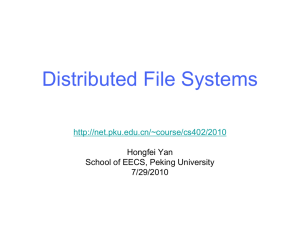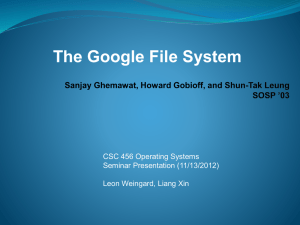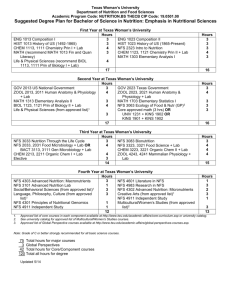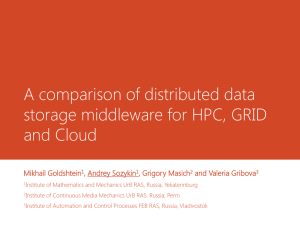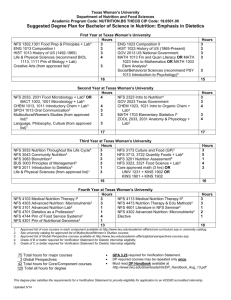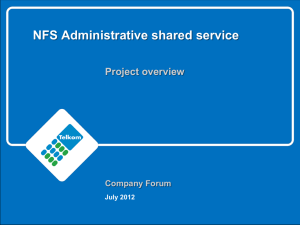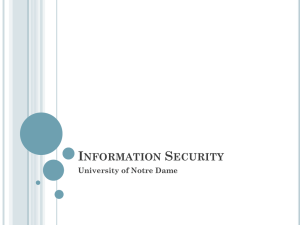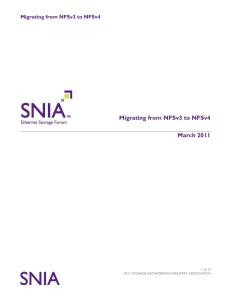Distributed File Systems – 1
advertisement
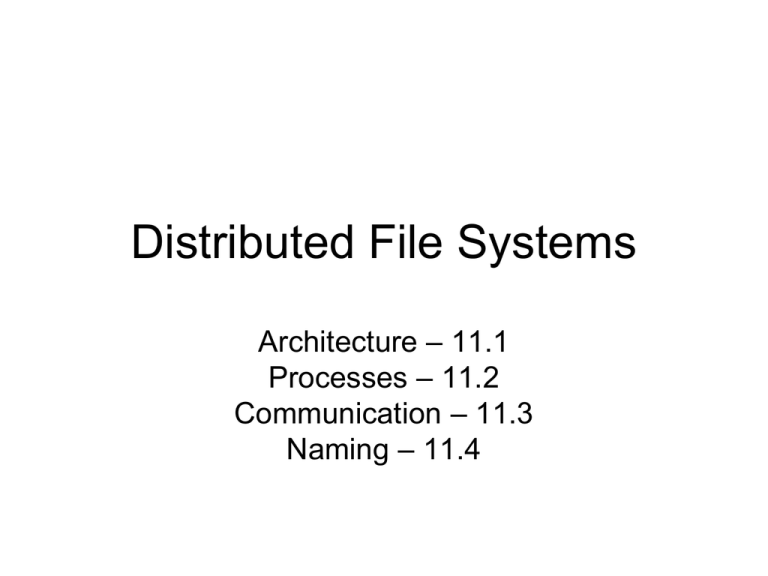
Distributed File Systems Architecture – 11.1 Processes – 11.2 Communication – 11.3 Naming – 11.4 Definition of a DFS • DFS: multiple users, multiple sites, and (possibly) distributed storage of files. • Benefits – File sharing – Uniform view of system from different clients – Centralized administration • Goals of a distributed file system – Network Transparency (access transparency) – Availability Goals • Network (Access)Transparency – Users should be able to access files over a network as easily as if the files were stored locally. – Users should not have to know the physical location of a file to access it. • Transparency can be addressed through naming and file mounting mechanisms Components of Access Transparency • Location Transparency: file name doesn’t specify physical location (Ch. 1) • Location Independence: files can be moved to new physical location, no need to change references to them. (A name is independent of its addresses – see Ch. 5) • Location independence → location transparency, but the reverse is not necessarily true. Goals • Availability: files should be easily and quickly accessible. • The number of users, system failures, or other consequences of distribution shouldn’t compromise the availability. • Addressed mainly through replication. Architectures • Client-Server – Traditional; e.g. Sun Microsystem Network File System (NFS) – Cluster-Based Client-Server; e.g., Google File System (GFS) • Symmetric – Fully decentralized; based on peer-to-peer technology – e.g., Ivy (uses a Chord DHT approach) Client-Server Architecture • One or more machines (file servers) manage the file system. • Files are stored on disks at the servers • Requests for file operations are made from clients to the servers. • Client-server systems centralize storage and management; P2P systems decentralize it. client client cache cache Communication Network cache Server Server Disks cache Server Architecture of a distributed file system: client-server model Sun’s Network File System • Sun’s NFS for many years was the most widely used distributed file system. – NFSv3: version three, used for many years – NFSv4: introduced in 2003 • Version 4 made significant changes Overview • NFS goals: – Each file server presents a standard view of its local file system – transparent access to remote files – compatibility with multiple operating systems and platforms. – easy crash recovery at server (at least v1-v3) • Originally UNIX based; now available for most operating systems. • NFS communication protocols lets processes running in different environments share a file system. Access Models • Clients access the server transparently through an interface similar to the local file system interface • Client-side caching may be used to save time and network traffic • Server defines and performs all file operations NFS - System Architecture • Virtual File System (VFS) acts as an interface between the operating system’s system call layer and all file systems on a node. • The user interface to NFS is the same as the interface to local file systems. The calls go to the VFS layer, which passes them either to a local file system or to the NFS client • VFS is used today on virtually all operating systems as the interface to different local and distributed file systems. Client-Side Interface to NFS Client process issues file system request via system call Other local file systems VFS Interface Local UNIX file system NFS client RPC client Stub NFS Client/Server Communication • The NFS client communicates with the server using RPCs – File system operations are implemented as remote procedure calls • At the server: an RPC server stub receives the request, “un-marshalls” the parameters & passes them to the NFS server, which creates a request to the server’s VFS layer. • The VFS layer performs the operation on the local file system and the results are passed back to the client. Server-Side Interface to NFS VFS Interface NFS server RPC Server Stub Local UNIX file system The NFS server receives RPCs and passes them to the VFS layer to process from the local file system. Other local file systems NFS as a Stateless Server • NFS servers historically did not retain any information about past requests. • Consequence: crashes weren’t too painful – If server crashed, it had no tables to rebuild – just reboot and go • Disadvantage: client has to maintain all state information; messages are longer than they would be otherwise. • NFSv4 is stateful Advantages/Disadvantages • Stateless Servers – Fault tolerant – No open/close RPC required – No need for server to waste time or space maintaining tables of state information – Quick recovery from server crashes • Stateful Servers – Messages to server are shorter (no need to transmit state information) – Supports file locking – Supports idempotency (don’t repeat actions if they have been done) File System Model • NFS implements a file system model that is almost identical to a UNIX system. – Files are structured as a sequence of bytes – File system is hierarchically structured – Supports hard links and symbolic links – Implements most file operations that UNIX supports • Some differences between NFSv3 and NFSv4 • See Figure 11-3, page 495 File Create/Open/Close • Create: v3 Yes, v4 No; Open: v3 No, v4 Yes; v4 creates a new file if an open operation is executed on a non-existent file • Close: v3 No and v4 Yes • Rationale: v3 was stateless; didn’t keep information about open files. Cluster-based or Clustered File System • A distributed file system that consists of several servers that share the responsibilities of the system, as opposed to a single server (possibly replicated). • The design decisions for a cluster-based systems are mostly related to how the data is distributed across the cluster and how it is managed. Cluster-Based DFS • Some cluster-based systems organize the clusters in an application specific manner • For file systems used primarily for parallel applications, the data in a file might be striped across several servers so it can be read in parallel. • Or, it might make more sense to partition the file system itself – some portion of the total number of files are stored on each server. • For systems that process huge numbers of requests; e.g., large data centers, reliability and management issues take precedence. – e.g., Google File System Google File System (GFS) • GFS uses a cluster-based approach implemented on ordinary commodity Linux boxes (not high-end servers). • Servers fail on a regular basis, just because there are so many of them, so the system is designed to be fault tolerant. • There are a number of replicated clusters that map to www.google.com • DNS servers map requests to the clusters in a round-robin fashion, as a load-balancing mechanism; locality is also considered. The Google File System • GFS stores a huge number of files, totaling many terabytes of data • Individual file characteristics – Very large, multiple gigabytes per file – Files are updated by appending new entries to the end (faster than overwriting existing data) – Files are virtually never modified (other than by appends) and virtually never deleted. – Files are mostly read-only Hardware Characteristics • Google is deliberately vague about the nature of its hardware, the size of its data centers, and even about where the data centers are located. • There are about 30 clusters world-wide http://www.slideshare.net/ultradvorka/google-cluster-innards , referenced 4/17/12 GFS Cluster Organization • A GFS cluster consists of one master and several “chunk servers”. • The chunk servers store the files in large (64 Mbyte) chunks – as ordinary Linux files • The master knows (more or less) where chunks are stored – Maintains a mapping from file name to chunks & chunks to chunk servers • Clients contact the master to find where a particular chunk is located. • All further client communication goes to the chunk server. File name, chunk index GFS client Master Contact address Instructions Chunk-server state Chunk ID, range Chunk data Chunk server Chunk Server Chunk Server Linux FS Linux FS Linux FS Figure 11-5. The organization of a Google cluster of servers GFS • Chunks are replicated within a cluster for fault tolerance, using a primary/backup scheme. • Periodically the master polls all its chunk servers to find out which chunks each one stores – This means the master doesn’t need to know each time a new server comes on board, when servers crash, etc. • Polling occurs often enough to guarantee that master’s information is “good enough”. Scalability in GFS • Clients only contact the master to get metadata, so it isn’t a bottleneck. • Updates are performed by having a client update the nearest server which pushes the updates to one of the backups, which in turn sends it on to the next and so on. – Updates aren’t committed until all replicas are complete. • Information for mapping file names to contact addresses is efficiently organized & stored (mostly) in the master’s memory. – Access time is optimized due to infrequent disk accesses. Symmetric File Systems Peer-to-Peer Symmetric Architectures • Fully distributed (decentralized) file systems do not distinguish between client machines and servers. • Most proposed systems are based on a distributed hash table (DHT) approach for data distribution across nodes. • The Ivy system is typical. It has a 3-layer structure. Ivy System Structure • The DHT layer implements a Chord scheme for mapping keys (which represent objects to be stored) to nodes. • The DHash layer is a block-storage layer – Blocks = logical file blocks – Different blocks are stored in different locations • The top, or file system layer, implements an NFS-like file system. Characteristics • File data and meta-data stored as blocks in a DHash P2P system • Blocks are distributed and replicated across multiple sites – increased availability. • Ivy is a read-write file system. Writing introduces consistency issues (of data and meta-data) Characteristics • Presents an NFS-like interface and semantics • Performance: 2X-3X slower than NFS • Potentially more available because of distributed nature Logs • Like most P2P systems, trustworthiness of users is not guaranteed – Must be able to undo modifications • Network partitioning means the possibility of conflicting updates – how to manage? • Solution: logs – one per user – Used to record changes made locally to file data and metadata – Contrast to shared data structures – Avoids use of locks for updating metadata Node where a file system is rooted File system layer Block-oriented layer DHT layer network Ivy DHash Chord DHash Layer • Manages data blocks (of a file) • Stored as content-hash block or public-key block • Content-hash blocks – Compute the secure hash of this block to get the key – Clients must know the key to look up a block – When the block is returned to a client, compute its hash to verify that this is the correct (uncorrupted) block. DHash Layer – Public Key Blocks • “A public key block requires the block’s key to be a public key, and the value to be signed using the private key.” • Users can look up a block without the private key, but cannot change data unless they have the private key. • Ivy layer verifies all the data DHash returns and is able to protect against malicious or corrupted data. DHash Layer • The DHash layer replicates each file block B to the next k successors of the server that stores B. – (remember how Chord maps keys to nodes) • This layer has no concept of files or file systems. It merely knows about blocks Ivy – the File System Layer • A file is represented by a log of operations • The log is a linked list of immutable (can’t be changed) records. – Contains all of the additions made by a single user (to data and metadata) • Each record records a file system operation (open, write, etc.) as a DHash content-hash block. • A log-head node is a pointer to the most recent log entry Using Logs • A user must consult all logs to read file data, (find records that represent writes) but makes changes only by adding records to its own log. • Logs contain data and metadata • Start scan with most recent entry • Keep local snapshot of file to avoid having to scan entire logs • Update: Each participant maintains a log of its changes to the file system • Lookup: Each participant scans all logs • The view-block has pointers to all log-heads Combining Logs • Block order should reflect causality • All users should see same order • For each new log record assign – A sequence # (orders blocks in a single log) – A tuple with an entry for each log showing the most recent info about that log (from current user’s viewpoint) • Tuples are compared somewhat like vector timestamps; either u < v or v < u or v = u or no relation (v and u are concurrent) • Concurrency is the result of simultaneous updates 11.2 – Processes in DFS • Typical types of cooperating processes: – Servers, file managers, client software • Should servers be stateless? – e.g., as in NFSv2 and v3 – but not NFSv4 • Advantage: Simplicity – Server crashes are easy to process since there is no state to recover Disadvantages of Statelessness • The server cannot inform the client whether or not a request has been processed. – Consider implications for lost request/lost replies when operations are not idempotent • File locking (to guarantee one writer at a time) is not possible – NFS got around this problem by supporting a separate lock manager. NFSv4 • Maintains some minimal state about its clients; e.g., enough to execute authentication protocols • Stateful servers are better equipped to run over wide area networks, because they are better able to manage consistency issues that arise when clients are allowed to cache portions of files locally 11.3: Communication • Usually based on remote procedure calls, or some variation. • Rationale: RPC communication makes the DFS independent of local operating systems, network protocols, and other issues that distract from the main issue. RPC in NFS • Client-server communication in NFS is based on Open Network Computing RPC (ONC RPC) protocols. • Each file system operation is represented as an RPC. Pre-version 4 NFS required one RPC at a time, so server didn’t have to remember any state. • NFSv4 supports compound procedures (several RPCs grouped together) Figure 11-7 client server client LOOKUP OPEN READ LOOKUP Lookup name Open file Read file data Return file handle READ Time server Time Return file data (a) Reading data from a file in NFS version 3 (b) Reading data from a file in NFS version 3 11.4 – Naming • NFS is used as a typical example of naming in a DFS. • Virtually all support a hierarchical namespace organization. • NFS naming model strives to provide transparent client access to remote file systems. Goal • Network (Access)Transparency – Users should be able to access files over a network as easily as if the files were stored locally. – Users should not have to know the location of a file to access it. • Transparency can be addressed through naming and file mounting mechanisms Mounting • Servers export file systems; i.e, make them available to clients • Client machines can attach a remote FS (directory or subdirectory) to the local FS at any point in its directory hierarchy. • When a FS is mounted, the client can reference files by the local path name – no reference to remote host location, although files remain physically located at the remote site. • Mount tables keep track of the actual physical location of the files. client X b c a g h d e f i Mount points Files from Server Y Files d, e, and f are on server Y; files j and k are on server Z, but from the perspective of server X all are part of the file system at that location j k Files from Server Z File Handles • A file handle is a reference to a file that is created by the server when the file is created. – It is independent of the actual file name – It is not known to the client (although the client must know the size) – It is used by the file system for all internal references to the file. Benefits of File Handles • There is a uniform format for the file identifier inside the file system (128 bytes, in NFSv4) • Clients can store the handle locally after an initial reference and avoid the lookup process on subsequent file operations QUESTIONS?
